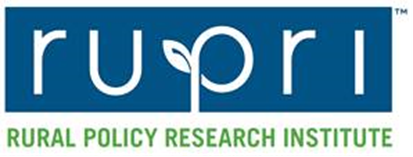The coronavirus has placed tremendous financial pressure on hospitals across the country. A new report explains that hospitals are suffering from the higher costs associated with treating COVID-19 patients and acquiring personal protective equipment, while also losing revenue from elective procedures stopping, which continue to be postponed in most states. The report estimates the country’s hospitals will be forced to bear $202.6 billion in losses between March 1st to June 30th, or about $50.7 billion per month. Hospitals cannot afford to continue losing revenue, especially rural hospitals who already operated on slim or negative margins.
New Rural Health Policy Paper: Considerations for Defining Rural Places in Health Policies and Programs

RUPRI Health Panel: Keith J. Mueller, PhD; Andrew F. Coburn, PhD; Alana Knudson, PhD; Jennifer P. Lundblad, PhD, MBA; A. Clinton MacKinney, MD, MS; Timothy D. McBride, PhD. Guest Authors – Erin Mobley, PhD; Fred Ullrich, BA; Abigail Barker, PhD
Rural definitions in statute and policy are used to direct resources to underserved peoples. But changes in population behavior and Census processes have led to concern about historic methods of defining rural. This paper identifies key questions; reviews rural definitions; and discusses options for reconsidering rural definitions.
Please click here to read the brief.
HRSA Releases Oral Health Workforce Projections for 2017–2030
HRSA has released their health workforce projections for dentists and dental hygienists in the U.S., 2017–2030. These projections inform policy decisions about workforce education, training, and delivery of care. Will there be an increase in the number of dentists in the U.S. by 2030? Will there be a decrease in the demand for full time dental hygienists?
New Penn State COVID-19 Report on Essential Work
The Penn State Institute of State and Regional Affairs (ISRA) released today the second installment of the COVID-19 Report Series: Employment Risk, quantifying the extent of establishments and employment effected by the COVID-19 pandemic and the closure of non-essential businesses.
The report uses current definitions for essential businesses paired with data on establishments, employment, and unemployment claims to assess the economic impact of the pandemic in Pennsylvania.
The key findings include:
- At least 1.2 million employees worked in industries impacted by business establishment closures.
- Over the four-week period from March 21 through April 4, nearly 1.7 million unemployment claims were filed.
Click here to read the latest report from ISRA’s COVID-19 Report Series for additional details on trends at the sector and county levels.
Policy Brief: Metropolitan/Nonmetropolitan COVID-19 Confirmed Cases and General and ICU Beds

Fred Ullrich, BA; and Keith Mueller, PhD
The spread of COVID-19 across rural areas has fueled concern about the availability of healthcare resources for dealing with the pandemic. This brief looks at a single measure of healthcare resources – hospital beds – and reports of current COVID-19 cases in a single week to assess the impact on rural facilities.
Please click here to read the brief.
Reopening Could Cause 233,000 Extra Deaths by June 30 but Save Up to 18M Jobs: Report
As states consider relaxing coronavirus lockdown orders, a new report estimates that fully reopening the economy would lead to an additional 233,000 deaths nationally by the end of June, relative to not reopening, but would at the same time save approximately 18.6 million jobs from being lost.
The University of Pennsylvania’s Penn Wharton Budget Model analyzed the health and economic effects of states partially reopening (lifting emergency declarations, stay-at-home orders, and school closures) as well as fully reopening, which would include businesses and restaurants as well.
The model, released on Friday, projects on a national level that if states do not open before June 30 and maintain status quo, the cumulative national deaths due to the virus would rise to about 117,000 by June 30 (including deaths before May 1), and approximately 18.6 million jobs would be lost between May 1 and June 30.
Rates of Living Alone by Rurality and Age
Living alone is associated with higher risk of social isolation and poor health for populations without access to appropriate support and resources. Little is known about how rates of living alone vary by rurality, however. In this infographic, the University of Minnesota Rural Health Research Center identifies rates of living alone for all adults and within specific age groups using two classifications of rurality. The report can be accessed here.
CRS Report on Health Care Provisions in Coronavirus Response Act
The Congressional Research Service (CRS) provides an overview of the healthcare-related provisions of the Families First Coronavirus Response Act, passed in response to the COVID-19 pandemic. The report focuses on coverage of COVID-19 testing and related items for individuals covered by Medicare, Medicare Advantage, Medicaid, CHIP, TRICARE, Veterans healthcare, the IHS, and most private plans. The report also includes a discussion of changes to Medicare coverage of telehealth services.
CDC: Reports to National Poison Data Center Related to COVID-19

In its most recent Morbidity and Mortality Weekly Report, the Centers for Disease Control and Prevention (CDC) reported an increase in chemical exposures related to cleaners and disinfectants for the period January-March 2020. Last week, the U.S. Department of Health & Human Services announced $5 million to support Poison Control Centers.
Read the report here.
Health Care Professional Workforce Composition Before and After Rural Hospital Closure

A new rural policy brief is available from the RUPRI Center for Rural Health Policy Analysis authored by Erin Mobley, PhD; Fred Ullrich, BA; Redwan Bin Abdul Baten, MPH; Mina Shrestha, MPH and Keith Mueller, PhD. This policy brief examines the composition of the local health care workforce before and after rural hospital closure to reveal any associations with discontinuation of inpatient services in rural communities.
Please click here to read the brief.
